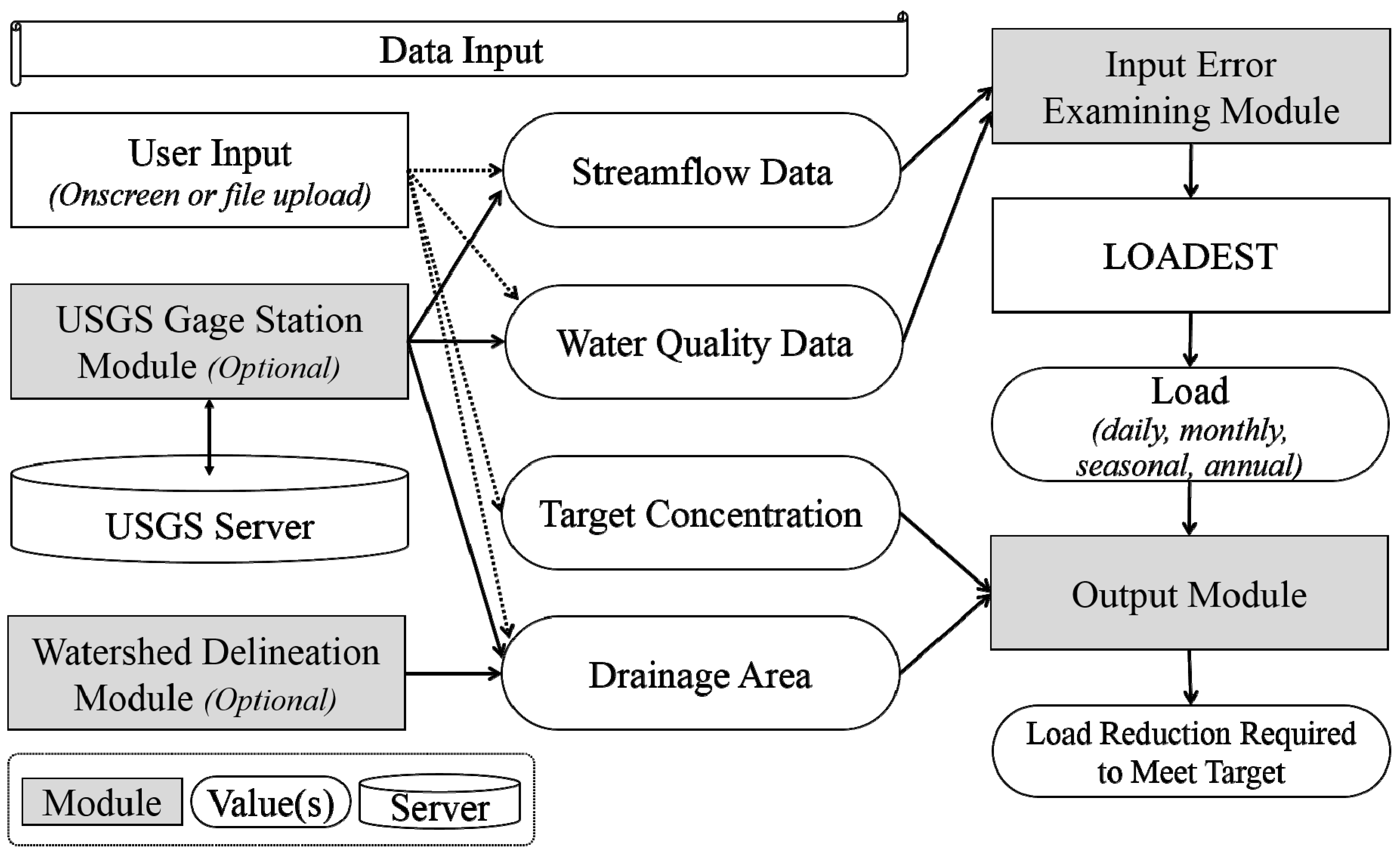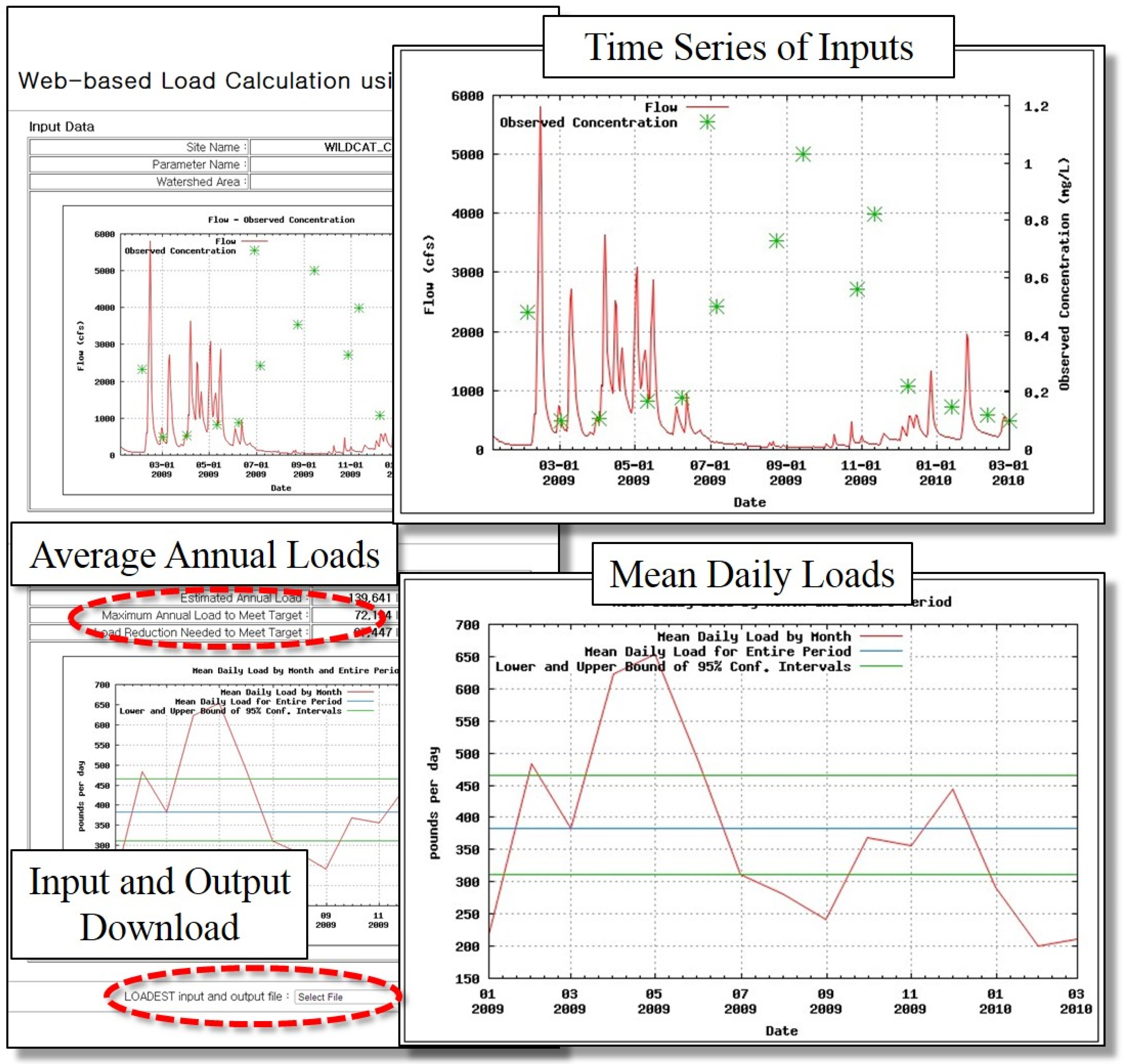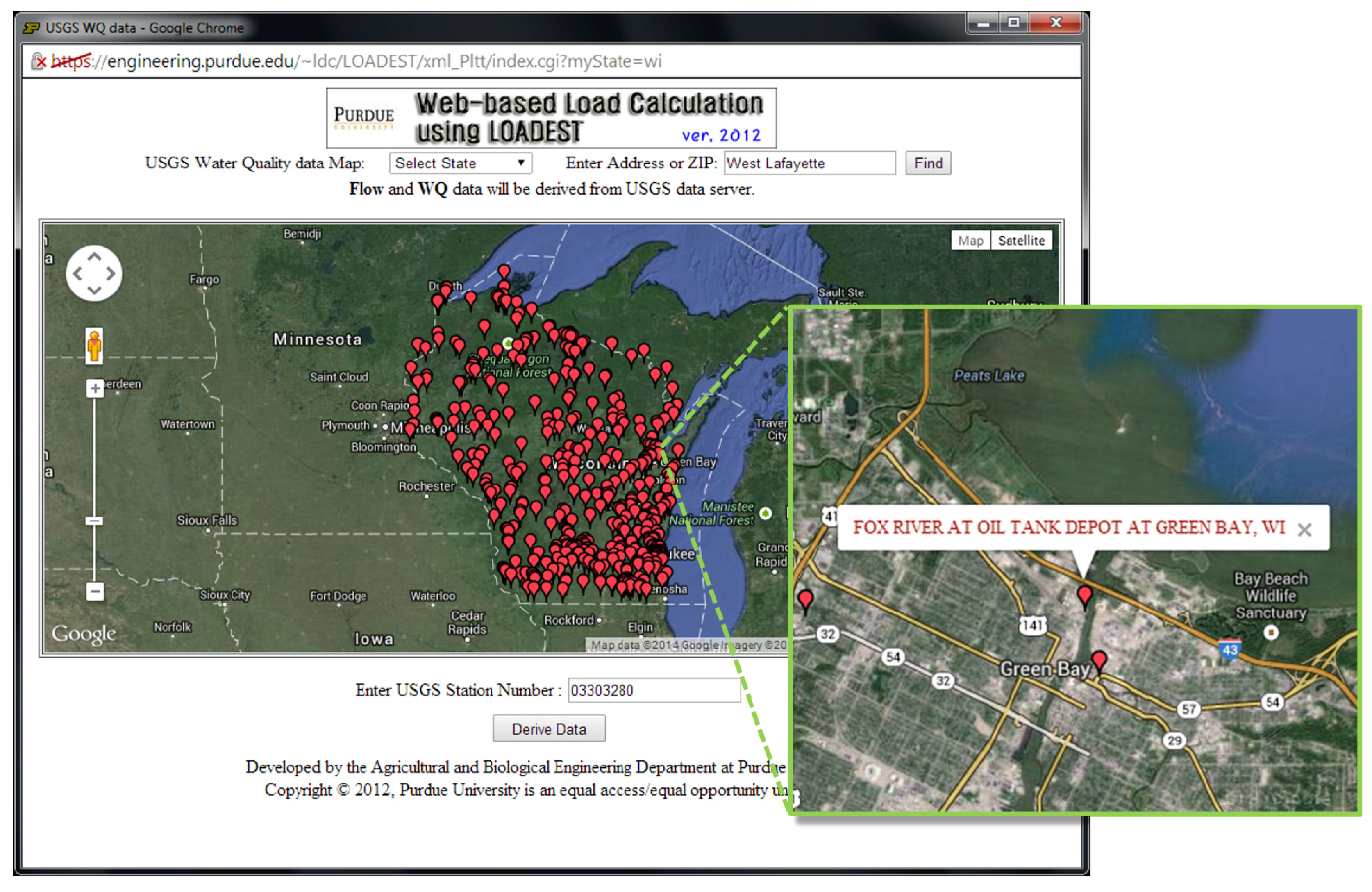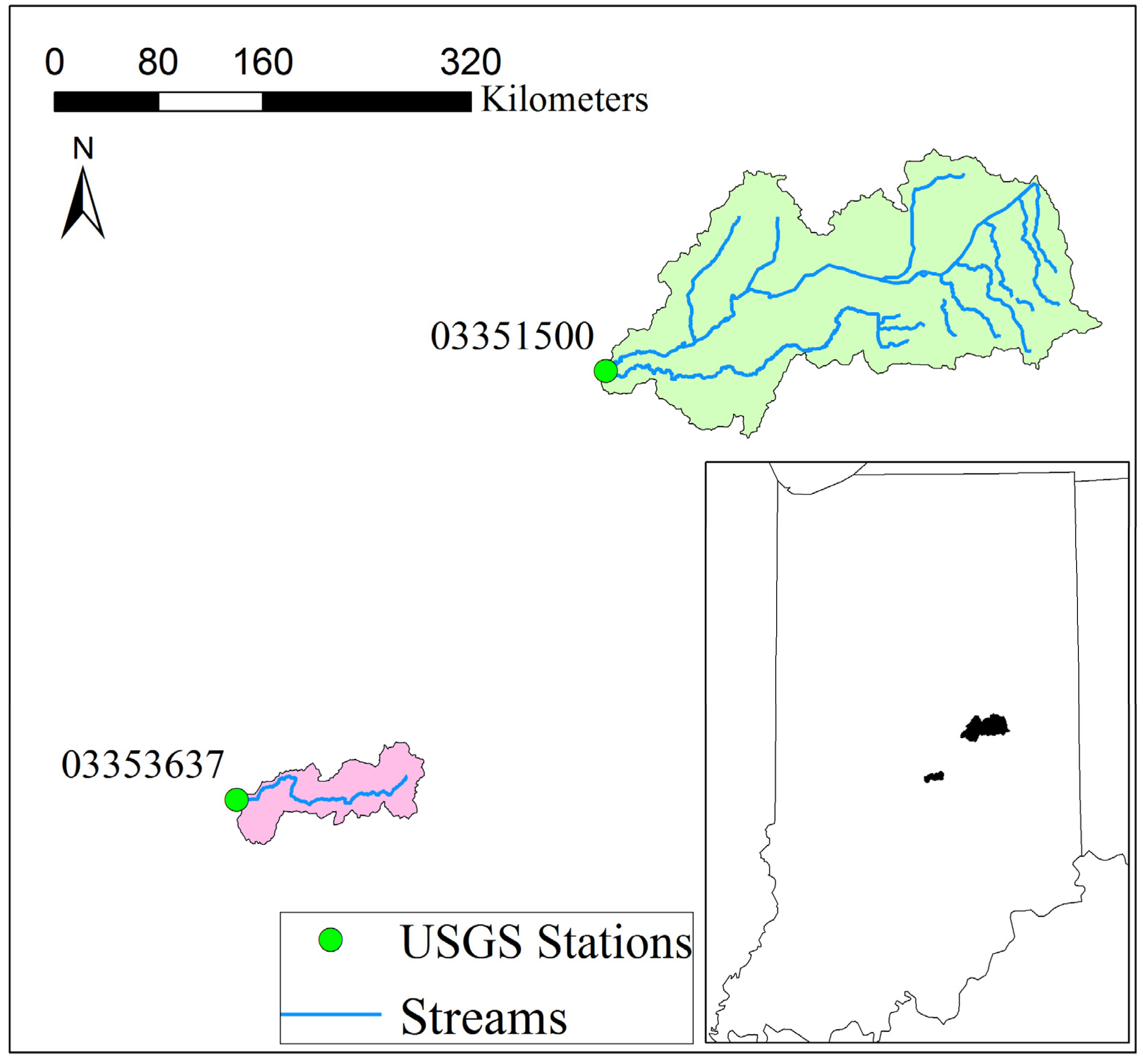A Web-Based Tool to Estimate Pollutant Loading Using LOADEST
Abstract
:1. Introduction
2. Materials and Methods



3. Application of LOADEST WEB
3.1. Demonstration of USGS Data Retrievals and Input Error Checking

3.2. Application for Average Annual Sediment Load Reduction

| USGS Station | Watershed Name | Total Area (km2) | Agriculture (km2) | Urban (km2) |
|---|---|---|---|---|
| 03351500 | Fall Creek near Fortville, IN | 438 | 326 | 51 |
| 03353637 | Little Buck Creek near Indianapolis, IN | 52 | 3 | 47 |
| USGS Station | Water Quality Target | Estimated Load | Required Reduction | ||
|---|---|---|---|---|---|
| (109 kg/year) | (kg/ha/year) | (109 kg/year) | (kg/ha/year) | ||
| 03351500 | 17.2 | 391.8 | 12.6 | 288.6 | 0% |
| 03353637 | 1.8 | 336.9 | 2.5 | 487.3 | 31% |
4. Conclusions
Acknowledgement
Author Contributions
Conflicts of Interest
References
- Park, Y.S. Development and Enhancement of Web-Based Tools to Develop Total Maximum Daily Load. Ph. D. Thesis, Purdue University, West Lafayette, IN, USA, 18 May 2014. [Google Scholar]
- Babbar-Sebens, M.; Karthikeyan, R. Consideration of sample size for estimating contaminant load reductions using load duration curves. J. Hydrol. 2009, 372, 118–123. [Google Scholar] [CrossRef]
- Henjum, M.B.; Hozalski, R.M.; Wennen, C.R.; Novak, P.J.; Arnold, W.A. A comparison of total maximum daily load (TMDL) calculations in urban streams using near real-time and periodic sampling data. J. Environ. Monitor. 2010, 12, 234–241. [Google Scholar] [CrossRef] [PubMed]
- Park, Y.S.; Engel, B.A.; Harbor, J. A web-based model to estimate the impact of best management practices. Water 2014, 6, 455–471. [Google Scholar] [CrossRef]
- Cohn, T.A.; Caulder, D.L.; Gilroy, E.J.; Zynjuk, L.D.; Summers, R.M. The validity of a simple statistical model for estimating fluvial constituent loads: An empirical study involving nutrient loads entering Chesapeake Bay. Water Resour. Res. 1992, 28, 2353–2463. [Google Scholar] [CrossRef]
- Gilroy, E.J.; Hirsch, R.M.; Cohn, T.A. Mean square error of regression-based constituent transport estimates. Water Resour. Res. 1990, 26, 2069–2077. [Google Scholar] [CrossRef]
- Johnson, A.H. Estimating solute transport in streams from grab samples. Water Resour. Res. 1979, 15, 1224–1228. [Google Scholar] [CrossRef]
- Horowitz, A.J. An evaluation of sediment rating curves for estimating suspended sediment concentrations for subsequent flux calculations. Hydrol. Proc. 2003, 17, 3387–3409. [Google Scholar] [CrossRef]
- Robertson, D.M.; Roerish, E.E. Influence of various water quality sampling strategies on load estimates for small streams. Water Resour. Res. 1999, 35, 3747–3759. [Google Scholar] [CrossRef]
- Robertson, D.M. Influence of different temporal sampling strategies on estimating total phosphorus and suspended sediment concentration and transport in small streams. J. Am. Water Resour. Assoc. 2003, 39, 1281–1308. [Google Scholar] [CrossRef]
- Toor, G.S.; Harmel, R.D.; Haggard, B.E.; Schmidt, G. Evaluation of regression methodology with low-frequency water quality sampling to estimate constituent loads for ephemeral watersheds in Texas. J. Environ. Qual. 2008, 37, 1847–1854. [Google Scholar] [CrossRef] [PubMed]
- Runkel, R.L.; Crawford, C.G.; Cohn, T.A. Load Estimator (LOADEST): A Fortran Program for Estimating Constituent Loads in Streams and Rivers; U.S. Geological Survey Techniques and Methods: Reston, VA, USA, 2004.
- Duan, S.; Kaushal, S.S.; Groffman, P.M.; Band, L.E.; Belt, K.T. Phosphorus export across an urban to rural gradient in the Chesapeake Bay watershed. J. Geophys. Res. 2012, 117. [Google Scholar] [CrossRef]
- Brigham, M.E.; Wentz, D.A.; Aiken, G.R.; Krabbenhoft, D.P. Mercury cycling in stream ecosystems. Water column chemistry and transport. Environ. Sci. Technol. 2009, 43, 2720–2725. [Google Scholar] [CrossRef] [PubMed]
- Dornblaser, M.M.; Striegl, R.G. Suspended sediment and carbonate transport in the Yukon River basin, Alska: Flouxes and potential future responses to climate change. Water Resour. Res. 2009, 45. [Google Scholar] [CrossRef]
- Oh, J.; Sankarasubramanian, A. Interannual hydroclimatic variability and its influence on winter nutrients variability over the southeast United States. Hydrol. Earth Syst. Sci. Discuss. 2011, 8, 10935–10971. [Google Scholar] [CrossRef]
- Park, Y.S.; Engel, B.A. Use of pollutant load regression models with various sampling frequencies for annual load estimation. Water 2014, 6, 1685–1697. [Google Scholar] [CrossRef]
- Purdue University. Web-based Load Calculation using LOADEST. Available online: https://engineering.purdue.edu/~ldc/LOADEST (accessed on 19 July 2015).
- Purdue University. Long-Term Hydrologic Impact Analysis. Available online: https://engineering.purdue.edu/mapserve/LTHIA7/index.html (accessed on 10 January 2013).
- U. S. Geological Survey. USGS Water-Quality Data for the Nation. Available online: http://waterdata.usgs.gov/nwis/qw (accessed on 19 July 2015).
- Michigan State University. Sieches on the Great Lakes. Available online: http://geo.msu.edu/extra/geogmich/seiches.htm (accessed on 6 September 2015).
- Indiana Department of Environmental Management (IDEM). Water quality targets. Available online: http://www.in.gov/idem/nps/3484.htm (accessed on 1 August 2014).
- National Water Quality Monitoring Council. Water Quality Portal. Available online: http://www.waterqualitydata.us/ (accessed on 1 August 2013).
© 2015 by the authors; licensee MDPI, Basel, Switzerland. This article is an open access article distributed under the terms and conditions of the Creative Commons Attribution license (http://creativecommons.org/licenses/by/4.0/).
Share and Cite
Park, Y.S.; Engel, B.A.; Frankenberger, J.; Hwang, H. A Web-Based Tool to Estimate Pollutant Loading Using LOADEST. Water 2015, 7, 4858-4868. https://doi.org/10.3390/w7094858
Park YS, Engel BA, Frankenberger J, Hwang H. A Web-Based Tool to Estimate Pollutant Loading Using LOADEST. Water. 2015; 7(9):4858-4868. https://doi.org/10.3390/w7094858
Chicago/Turabian StylePark, Youn Shik, Bernie A. Engel, Jane Frankenberger, and Hasun Hwang. 2015. "A Web-Based Tool to Estimate Pollutant Loading Using LOADEST" Water 7, no. 9: 4858-4868. https://doi.org/10.3390/w7094858





